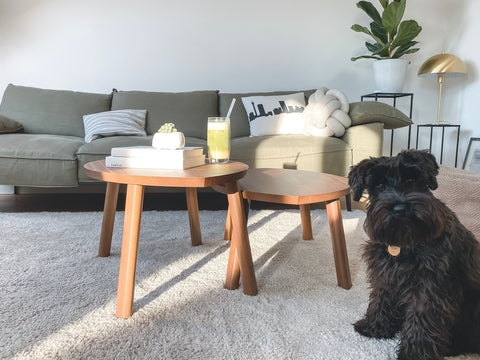Mould quickly grows in damp and rainy weather making it a constant feature on soft furnishings. Mould begins as a white or pink fuzzy growth and may initially go unnoticed, it then becomes green or black and if not removed or treated can end up staining your carpet or sofa and spreading to other areas of the home.

10 Tips For Treating Mould On Carpet & Upholstery
-
Leaks – Identify and any repair leaks. Check areas that are vulnerable to water build-up such as low points or areas that can become clogged with debris.
-
Remove moisture - Whilst tidying your home make it part of your daily routine to wipe down surfaces with a dry towel including windows to reduce moisture and condensation sitting on the interior surfaces. Also, wipe down all bathroom surfaces after a shower.
-
Ventilation – open vents and turn on fans to circulate the air. An additional step is to install an electric ventilation system to create a stronger movement of air and circulation throughout the home.
-
De-humidify – when a home is left closed up mould can begin to grow. Use the de-humidifying setting on your air conditioning system. Alternatively, you can purchase a stand-alone dehumidifier and keep it running whilst the doors are closed. Stand-alone dehumidifiers are available at electrical and department stores. Ensure any water running off the de-humidifier flows out of the house and does not build up inside.
-
Clean – Dust and dirt sitting on surfaces provide a perfect foothold for mould spores to latch on to. As well as vacuuming your sofa and carpets, also wipe or dust cupboards, walls, light fittings, curtains, blinds, and ceilings.
-
De-clutter – Having a lot of items on in the home encourages an environment of dust, dirt, and dampness which will promote mould growth. You may not think that you have a lot of items but just keeping and storing the absolute essentials will help you to reduce the number of items.
-
Sunshine – wherever possible, open curtains and blinds and allow the sun to shine into the home as this will help to reduce mould. Having fewer items will also mean that the sun’s light will touch more surfaces, dry any dampness and kill mould sitting there.
-
Wet or damp items – Promptly remove any washed or laundered items from inside the bathroom or laundry and leave to dry in the open air. Any wet towels or clothes should be left outside to dry completely before being taken inside and stored.
- Remove mouldy items - Any loose items, clothes, towels, linens, curtains, etc that cannot be effectively treated for mould should be removed completely so as to avoid the mould spreading to other areas of the home through the release of spores. Dispose of cloths used to clean mould.
- Mould stains on upholstery - To treat mould stains on soft surfaces such as upholstery, curtains, or canvas use a cleaning product that treats the stain as well as killing the mould. The Oil of Cloves Carpet & Upholstery Cleaner is especially suited to this purpose. With any cleaner, always test on an inconspicuous area first. The longer mould sits on a surface the more severe the stain and harder to treat so always treat stains as soon as you notice any discolouration from mould.

Leave a comment